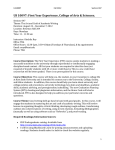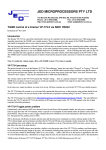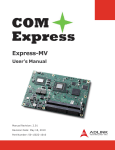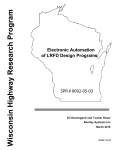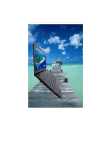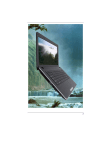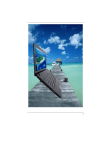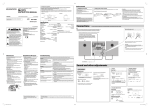Download User's Guide BML-S1B0-Q_ _ _-M_ _ _-_0-KA_ _ BML-S1E0
Transcript
BML-S1B0-Q_ _ _-M_ _ _-_0-KA_ _ BML-S1E0-Q_ _ _-M_ _ _-_0-KA_ _ english User's Guide Balluff GmbH Schurwaldstrasse 9 73765 Neuhausen a.d.F. Germany Phone +49 7158 173-0 Fax +49 7158 5010 Servicehotline +49 7158 173-370 [email protected] www.balluff.com BML-S1B0-Q_ _ _-M_ _ _-_0-KA_ _ BML-S1E0-Q_ _ _-M_ _ _-_0-KA_ _ Linear Position Encoder Content 1 Safety Advisories 1 1.1 1.2 1.3 1.4 Safety Advisories .................. 2 Intended use .......................... 2 Qualified personnel ................ 2 Use and testing ...................... 2 Validity .................................... 2 Read this manual before installing the sensor and placing it in operation. 2 3 Functional variants ............... 3 Function and Characteristics ..................... 4 Characteristics ....................... 4 Principle of operation ............. 4 Interface signals ..................... 4 Limit switch function .............. 4 Reference point function ........ 5 The BML displacement sensor is fitted into a machine or piece of equipment for its application. Together with a controller (PLC) it comprises a displacement measurement system and may be used only for this purpose. 3.1 3.2 3.3 3.4 3.5 4 Installing the sensor ............. 6 4.1 Installing sensor and magnetic tape (linear motion) ................. 6 Distances, tolerances ............. 6 Determining orientation .......... 7 Attaching sensor head ........... 7 Selecting the tape .................. 7 Installing limit switches .......... 8 4.2 Installing sensor and magnet ring (rotary motion) ................. 8 5 Wiring .................................... 9 5.1 Cable assignments ................. 9 5.2 Connecting the Sense line ..... 9 5.3 Interfaces ............................. 10 6 Selecting the Appropriate BML and Controller System ......... 11 6.1 Standard BML ...................... 11 6.2 BML with predefined traverse speed ...................... 11 6.3 BML system with magnet ring .... 12 7 7.1 7.2 7.3 7.4 7.5 8 8.1 8.2 9 10 11 12 Startup ................................. 14 Checking connections ......... 14 Turning on the system .......... 14 Checking system function .... 14 Regular checking ................. 14 Malfunction .......................... 14 Accessories ........................ 14 Limit switch magnets ........... 14 Cover strip ............................ 14 Troubleshooting .................. 15 Technical Data .................... 16 Scope of Delivery ............... 17 Versions (indicated on part label) ............................ 18 1.1 Intended use Unauthorized modifications and non-allowed use will result in loss of guarantee and warranty. 1.2 Qualified personnel This manual is intended for technical personnel who are involved in installation and setup. 1.3 Validity This Guide is valid for displacement sensors models BML-S1B0-Q-...-KA_ _ and BML-S1E0-Q-...-KA_ _ An overview of the various versions can be found in section 12 "Versions" (refer to part label). Prevailing safety regulations and codes must be observed for using the displacement sensor. The CE Mark verifies that our products meet the requirements of EC Directive 89/336/EEC (EMC Directive) and the EMC Law. Testing in our EMC Laboratory, which is accredited by DATech for Testing Electromagnetic Compatibility, has confirmed that Balluff products meet the EMC requirements of the following Generic Standards: EN 61000-6-2 (noise immunity) english 1.4 Use and testing EN 61000-6-4 (emission) 2 In particular, measures must be taken to ensure that a defect in the displacement sensor will not result in hazards to persons or equipment. This includes installation of additional safety limit switches, emergency stop switches, and the maintaining of permissible ambient conditions. BML displacement sensors may not be used in life-saving systems, in aircraft, etc. Emission tests: RF Emission EN 55011 Group 1, Class A+B Noise immunity tests: Static electricity (ESD) EN 61000-4-2 Severity level 3 Electromagnetic fields (RFI) EN 61000-4-3 Severity level 3 Fast transients (Burst) EN 61000-4-4 Severity level 3 Surge EN 61000-4-5 Severity level 2 Line-induced noise induced by high-frequency fields EN 61000-4-6 Severity level 3 Magnetic fields EN 61000-4-8 Severity level 4 BML-S1B0-Q_ _ _-M_ _ _-_0-KA_ _ BML-S1E0-Q_ _ _-M_ _ _-_0-KA_ _ Linear Position Encoder 2 Functional variants of the displacement sensor The BML is a non-contact, incremental displacement feedback system consisting of a sensor head and a magnetic tape. The system is available in several variants: with position signal function only, with additional reference point function and/or with limit switch function. All functions are implemented by means of magnetic sensing. The reference position is integrated in the tape, and limit switch magnets can be attached at any desired position. The following table show the functional variants with their possibilities. Limit switch sensors Incremental sensors Output signal A-Signal B-Signal Reference signal none Single signal Pole-periodic Fixed periodic Reference point sensor Fig. 2-1: Sensor head configuration Limit switch Front and rear Tape with alternating north and south poles System variant 1: No reference point signal BML-M0_...-R0000 BML-S1B1...M_0_ Tape with one ref. point System variant 2: One reference point signal BML-M0_...-Rxxxx BML-S1B1...M_1_ System variant 3: Pole-periodic reference point signals BML-M0_...-R0000 BML-S1B1...M_2_ Tape with multiple ref. points at equal distances System variant 4: Fixed periodic reference point signals BML-M0_...-Cxxxx BML-S1B1...M_1_ Fig. 2-2: Length measurement systems Note: For a detailed technical description and installation instructions for tapes, see User's Guide for tape at www.balluff.de Limit switch magnet Fig. 2-3: Length measurement system with limit switch sensors, tape with reference points and limit switch magnets english 3 BML-S1B0-Q_ _ _-M_ _ _-_0-KA_ _ BML-S1E0-Q_ _ _-M_ _ _-_0-KA_ _ Linear Position Encoder 3 Function and Characteristics 3.1 Characteristics BML displacement sensors are characterized by: – High system accuracy of 50 µm – High resolution of up to 5 µm – High traverse speed of up to 20 m/s – Position signal in real-time – Insensitive to shock, vibration, and contamination such as dust and oil – Wear- and maintenance-free – Rugged – Enclosure rating IP 67 per IEC 60529 3.2 Principle of operation The sensing head is attached to the machine member whose position is to be determined, while the magnetic tape is mounted along the direction of travel. The tape contains alternating magnetic northand south poles. The two incremental sensors in the sensing head measure the magnetic alternating field. As the sensing head travels over the tape the two incremental sensors pick up the magnetic periods so that the controller can determine the distance traveled. 3.3 Interface signals The sensing head can convert the sinusoidal and cosinusoidal signals either into A/B pulses and send them to the controller (RS422). The digital A/B pulses are interpolated in the sensing head. The two digital pulses A and B are 90° phase-shifted, with the sign of the phase shift determined by the direction of travel of the sensor (Fig. 3-1). Each edge change from A or B represents a counting step for the period counter (UP/DOWN counter). When Signal A is ahead, the counting state increases, and when Signal B is ahead the count decreases. The controller thus always knows the increment-precise position without having to periodically poll the sensor (realtime capability). Note, for correct function the A and B signals must be evaluated direction-dependent. Signal A Signal B Increment Forwards Direction of motion Backwards Counter state Fig. 3-1: Digitized sinusoidal and cosinusoidal signals with period counter 3.4 Limit switch function When limit switch functionality is needed, sensing heads can be equipped in addition with a limit switch sensor which senses opposite pole permanent magnets at the ends of the measuring range and sends the signals to the controller (Fig. 3-2). Limit switch sensors Limit switch magnet rear The limit switch sensors function then even if the rest of the sensor fails (security function). If the actuation range of the limit switches needs to be longer than their length (20 mm), multiple limit switches of the same type can be mounted in rows. Incremental sensors Limit switch magnet front Fig. 3-2: Displacement measurement system with limit switch function 4 english BML-S1B0-Q_ _ _-M_ _ _-_0-KA_ _ BML-S1E0-Q_ _ _-M_ _ _-_0-KA_ _ Linear Position Encoder 3 Function and characteristics (cont.) 3.5 Reference point function The reference position is always required as the starting point for the count for each incremental displacement system. How the reference position is determined depends on the sensor type, the tape and on the controller. – In the simplest system the sensing head with the sinusoidal and cosinusoidal sensors can count only the magnetic periods. The tape contains only one track with magnetic north and south poles (Fig. 3-3). In this case the displacement measuring system does not know the absolute position. This is determined by the controller by adding the counted increments. First however the reference position must be determined by a homing move to the reference switch. – A sensing head with an additional reference point sensor can output a reference point signal as soon as it reaches the magnetically encoded reference point on the second track of the tape (Fig. 3-4). An external reference switch is not needed. – In another sensing head version a reference point signal is output with each magnetic pole (Fig. 3-3). The signal is repeated every 5 millimeters (poleperiodic). The tape does not require a second track with a magnetically encoded reference point. In this case a reference switch needs to be used for the selected reference signal. The controller precisely evaluates the reference position when the switch and the reference point signal of the sensing head are active. Therefore the accuracy requirement for this switch is not especially great. – The sensor head with an additional reference point sensor can also be combined with a magnetic tape having fixed periodic reference points (Fig. 3-4). Here the reference points are integrated across the entire length of the tape at certain constant intervals, such as every 10 cm. To determine the exact position, the reference move must cover the entire length of the tape up to the external reference switch. Advantages of the pole-periodic and fixed periodic tapes: You can purchase the tape in long lengths and trim it yourself to length. Incremental sensors Tape without reference point/with pole-periodic reference point Fig. 3-3: Displacement measurement system with or without pole-periodic reference point Tape with one reference point Reference point sensor Magnetic reference point Tape with fixed periodic referenced points Magnetic reference points Fig. 3-4: Displacement measurement system with reference point function english 5 BML-S1B0-Q_ _ _-M_ _ _-_0-KA_ _ BML-S1E0-Q_ _ _-M_ _ _-_0-KA_ _ Linear Position Encoder 4 Installing the Sensor Important installation notes: The permissible distance and angle tolerances as per Figs. 4-2, 4-3 and 4-4 must be strictly observed. The sensing head may not come in contact with the tape at any point along the travel. Contact must still be avoided if the stainless steel cover (optional) is used. The magnetic tape must not be subjected to strong external magnetic fields. Direct contact with holding solenoids or other permanent magnets must be avoided. The displacement measurement system must be installed in accordance with the specified enclosure rating. 4.1 Fig. 4-1: Dimensional drawing Distances, tolerances The following distances and tolerance must be observed when installing the sensing head and tape: – The distance (air gap) between sensing head and tape as per Fig. 4-2 – The horizontal offset between sensing head and tape as per Fig. 4-3 – The angle tolerances as per Fig. 4-4. Any tilt along the longitudinal axis of the sensing head must still maintain the nominal distance to the tape in the center of the head. The two incremental sensors are located there on the underside. Magnetic tape Stainless steel cover strip Fig. 4-2: Permissible air gap between sensor head and tape BML without reference point or with pole-periodic reference point BML with single or fixed-periodic reference point Fig. 4-3: Permissible horizontal tolerance to right or left Note: Even slight tolerance deviations can affect the measuring result. The specified system accuracy applies only if the tape is installed parallel to the direction of travel. Fig. 4-4: Permissible angle tolerances 6 english Magnetic tape BML-S1B0-Q_ _ _-M_ _ _-_0-KA_ _ BML-S1E0-Q_ _ _-M_ _ _-_0-KA_ _ Linear Position Encoder 4 4.2 Installing the Sensor (cont.) Determining orientation 4.3 The sensor head should be secured with M3 screws, with its right or left side against the machine part whose position is to be determined. Important! No forces allowed on the housing cable. Provide strain relief for the cable. Left side Recommendation for selecting the tape BML-S1B: Tape BML-M02-I45 System accuracy ±10 µm BML-S1E: Tape BML-M02-I46 or magnet rings Note: For a detailed technical description and installation instructions for tapes, see User's Guide for tape at www.balluff.de Front Rear The alignments at the front, rear and left are referred to in the installation description and are essential for the correct installation of the sensing head and tape. Starting from the travel direction of the sensing head the orientations are defined in Fig. 4-5. Attaching sensor head Direction of travel Right side Reference point Fig. 4-5: Orientation Right side Limit switch magnet rear 4.5 Limit switch magnet front Installing limit switches The front and rear limit switch magnets must always be installed on the right side of the sensing head. When the limit switch is in a housing always attach the front magnet with its nose facing back and the rear magnet with its nose facing front. Limit switch magnet rear: Slot left of center Fig. 4-6: Installing the limit switch magnets When the limit switch is not in a housing, attach the rear magnet with the slot to the left of center and the rear magnet with the slot right of center (Fig. 4-6, 4-8). The following applies to both limit switch types: If the E-stop travel exceeds the length of the limit switch magnet, multiple magnets may be installed in a row (Fig. 4-7). For ordering information see Section 7.1. The limit switch sensor becomes active as soon as it begins to enter the magnetic field of the limit switch magnet (Fig. 4-8). Limit switch magnet front: groove right of center The limit switch sensor is activated at about this position Emerg. stop travel Travel direction (measuring range) Emerg. stop travel Fig. 4-7: Traverse and emergency stop distances for limit switches with and without housing Sensor head Limit switch adhered to the machine Maintain distance from mounting surface Magnetic tape Fig. 4-8: Installation example for limit switch without housing english 7 BML-S1B0-Q_ _ _-M_ _ _-_0-KA_ _ BML-S1E0-Q_ _ _-M_ _ _-_0-KA_ _ Linear Position Encoder 4 4.2 Installing the Sensor (cont.) Installing sensor and magnet rings (rotary motion) Important installation notes: The permissible distance and angle tolerances as per Figs. 3-5, 3-6 and 3-7 must be strictly observed. The sensor head must not be allowed to touch the magnet ring. The magnetic tape must not be subjected to strong external magnetic fields. Direct contact with holding solenoids or other permanent magnets must be avoided. The displacement measurement system must be installed in accordance with the specified enclosure rating. Rear view with cable The sensor can be installed with the cable entry to the right or left with respect to the magnet ring (Fig. 410). Note: For a detailed technical description and installation instructions for magnet rings, see User's Guide at www.balluff.de Front view Incremental sensors Fig. 4-9: Permissible gap 8 english Fig. 4-10: Permissible r axial offset Fig. 4-11: Permissible tangential offset BML-S1B0-Q_ _ _-M_ _ _-_0-KA_ _ BML-S1E0-Q_ _ _-M_ _ _-_0-KA_ _ Linear Position Encoder 5 Wiring Note the following when making electrical connections: The system and the control cabinet must be at the same ground potential. To ensure EMC, which Balluff confirms with the CE Marking, the following instructions must be followed. 5.1 Cable assignments 12-conductor cable with Sense line (measurement line) for preventing voltage drop in the incoming line. Cable WH BN GN YE GY PK BU RD BK VT GYPK RDBU TR BK** white brown green yellow gray pink blue red black violet gray/pink red/blue transp. black Signal A*** /A or n.c.* B*** /B or n.c.* Z (Ref. signal) /Z or n.c.* GND*** +5 V or 24 V*** GND Sense +5/24 V Sense Front limit switch Rear limit switch Shield 0.34 mm2 Shield 0.34 mm2 The cable shield must be grounded on the controller side, i.e., connect to the protection ground. When routing the cable between the transducer, controller and power supply avoid proximity to high-voltage lines due to noise coupling. Especially critical are stray coupling caused by AC harmonics (e.g., from phase controls), against which the cable shield offers little protection. 5.2 Cable length max. 20 m; conductor cross-section min. 0.14 mm2, max. 0.5 mm2. Longer cables may be used if their construction, shielding and routing resist external noise fields. Important: In spite of a voltage drop in the line a nominal operating voltage of 10 to 30 V or 5 V ±5% must be ensured (see 5.2). Connecting the Sense line To avoid voltage drop in the cable, when operating at 5 V a controlled mains adapter with polarity sensing input should be used (Fig. 5-1). If that is not possible or desired, the Sense lines in the 12-conductor cable should be connected parallel to the +5 V and GND line (Fig. 5-2). When operating at 10...30 V it must only be ensured that the voltage does not fall below 10 V. Such a power supply does not normally possess a Sense line. Power supply Fig. 5-1: 5 V Power supply with Sense line Power supply Fig. 5-2: 5 V Power supply without Sense line * Applies only to BML-S1B0-Q53 and BML-S1E0-Q53. ** Discontinued version. *** These wires only for BML-S1B0-Q53_-M400 and BML-S1E0-Q53_-M400. Calculating the voltage drop in the line Sample calculation For the 5 V version of the BML the supply voltage must be 5 V ±5%. The power supply must ensure this voltage and also compensate for the voltage drop in the line. When operating at 10...30 V the voltage must be >10 V. Under the following conditions: cable length 5 m Reference pulse is evaluated Control input impedance = 120 Ω Use the following formula to calculate the voltage drop in the line: Vline = Rl x l x [n x 3.1/Rst + 0.03] where: Vline Rl l n Rst = = = = Voltage drop in the line in Volt 0.23 for the parallel wiring of the Sense lines with the supply lines (Fig. 5-2) Cable length in m 3, if the reference pulse is processed in the controller 2, if the reference pulse is not processed in the controller = Input impedance of the controller in Ohm Resulting voltage drop is: Vline = 0.23 x 5 x [3 x 3.1/120 + 0.03] = 0.1 V english 9 BML-S1B0-Q_ _ _-M_ _ _-_0-KA_ _ BML-S1E0-Q_ _ _-M_ _ _-_0-KA_ _ Linear Position Encoder 5 5.3 Wiring (cont.) Circuit for reference position Interfaces Digital incremental system The sensor transmits the measured variable to the controller as a digital differential voltage signal (RS422) or as an operating voltage signal (HTL). The edge separation A/B corresponds to the resolution of the sensing head. Signal period 360° el. Depending on the model, the sensor sends either no reference signal, a single reference signal which is magnetically encoded in the tape, or a periodic reference signal (period = 5 mm, width of the reference signal = edge separation, Fig. 5-3). In the latter case an external reference switch must be attached to the desired reference signal. Circuit for limit switches front and back The opposite poled permanent magnets at the ends of the measuring range are each sensed by a limit switch sensor. The sensor has a normally closed function, so that cable break can be detected. Controller Limit switch front Rear limit switch The accuracy requirements of this switch are not especially high. Note: The reference signals from the limit switch area are not allowed to be processed. Fig. 5-6: Limit switch circuit Edge separation Reference pulse Reference signal for the controller el. Rear limit switch External switch Front limit switch Fig. 5-3: Digital output signals Fig. 5-5: Reference position circuit Fig. 5-7: Limit switch signals A-channel Relationship between mechanical resolution and max. frequency B-channel The requirements for your controller (counting frequency) and for the traverse speed of your system can be determined from the BML model used (see part numbering code, p. 18). Note the values from the following table. Reference channel * only for BML S1B0-Q61... ** only for BML S1B0-Q51... The 24 V inputs are connected to digital inputs on the controller. Fig. 5-4: Circuit for following electronics 10 english Example for table line 1: Using a BML with a resolution of 5 µm and a max. speed around 1 m/s ("slow" model) the results are as follows: - The smallest edge separation which your controller must be able to count is 3.1 µs. BML-S1B0-Q_ _ _-M_ _ _-_0-KA_ _ BML-S1E0-Q_ _ _-M_ _ _-_0-KA_ _ Linear Position Encoder 6 Selecting the Appropriate BML and Controller System Tables 6 -1 and 6 -2 show the relationship between the mech. resolution, the min. edge separation and the max. traverse speed for BML systems using a magnetic tape. Important! The controller/display must be able to count the minimum time-based edge separations shown in the tables (note the counting frequency of your controller). The min. edge separation may even be present in the stopped state due to the internal interpolation procedure. 6.1 Standard BML (Tab. 6-1) Determining the appropriate BML system for an existing controller (linear motion) Example (see Table 6-1) Assumptions: – Your controller can detect a min. edge separation of 1.8 µs. If there is no BML with this min. edge separation, select a BML with greater edge separation. – The max. traverse speed of the system should be 2 m/s. Determining the appropriate BML: – You need a BML with min. edge separation 2 µs (H-type). – To be able to traverse at max. 2 m/s, select the model with 10 µm resolution (G-type). 6.2 With the standard BML the maximum traverse speed depends on the edge separation and on the resolution (see Table 6-1). In the table the X indicates the min. edge separation in time of the BML model and Y the mechanical resolution (see part numbering code). BML - S1A1 - Q61Y - M313 - X0 - KA05 (model example) Edge separation Mechanical resolution Standard BML F = 5 µm Resolution Y: G = 10 µm H = 25 µm K = 50 µm Edge sep. X Vmax corresponding to edge separation and resolution D = 0.12 µs 20 m/s 20 m/s 20 m/s 20 m/s E = 0,29 µs 10 m/s 20 m/s 20 m/s 20 m/s F = 0,48 µs 5 m/s 10 m/s 20 m/s 20 m/s G = 1 µs 3.25 m/s 6.5 m/s 14.75 m/s 14.75 m/s H = 2 µs 1.5 m/s 3 m/s 7.7 m/s 7.7 m/s K = 4 µs 0.75 m/s 1.5 m/s 3.95 m/s 3.95 m/s L = 8 µs 0.375 m/s 0.75 m/s 1.7 m/s 1.7 m/s N = 16 µs 0.195 m/s 0.395 m/s 0.95 m/s 0.95 m/s P = 24 µs 0.13 m/s 0.26 m/s 0.65 m/s 0.65 m/s Table 6-1: Standard BML with defined min. edge separations Determining the appropriate controller for an existing BML system (linear motion) What does the max. counting frequency of the controller need to be? The period of the input signal is 4x the edge separation (see Fig. 5-3). The max. frequency of the input signal is then 1/(4× edge separation). Example: With an edge separation of 1 µs for the model G BML, the max. frequency of the input signal is 1/4 µs = 250 kHz. The max. counting frequency for 4x evaluation is 1/edge separation = 1/1 µs = 1 MHz. BML with predefined traverse speed (predecessor to the standard BML) Linear motion The requirements for your controller (counting frequency) and for the traverse speed of your system can be determined from the BML model used (see part numbering code). Note the values from following table 6-2. Example (see Table 6-2, column 2): For a BML model with 5 µm resolution (F-type) and a max. speed of 1 m/s (type code 1) the following apply: - The smallest edge separation which your controller must be able to count is 3.1 µs. In the table X indicates the max. traverse speed for the BML model and Y the mechanical resolution. BML - S1A1 - Q61Y - M313 - X0 - KA05 (model example) max. traverse speed (code 1 or 2) mech. resolution (For code see Tab. 6-2) Predecessor BML F = 5 µm Vmax X Resolution Y: G = 10 µm H = 25 µm K = 50 µm min. possible edge separation 1 = 1 m/s 3.1 µs 6 µs 15.8 µs 15.8 µs 2 = 10 m/s 0.29 µs 0.58 µs 1.56 µs 1.56 µs Table 6-2: Predecessor BML with defined max. traverse speeds english 11 BML-S1B0-Q_ _ _-M_ _ _-_0-KA_ _ BML-S1E0-Q_ _ _-M_ _ _-_0-KA_ _ Linear Position Encoder 6 6.3 Selecting the Appropriate BML and Controller System Determining resolution and max. rotational speed for BML systems with magnet ring (rotary motion) Step 1 Magnet ring type First decide how many pulses per revolution your application requires. This will be used to select the magnet ring outside diameter, the resolution of the sensor head, and the sensor head model (BML-S1B..., -S1E...). Table 6-3 shows for each magnet ring the relationship between the number of pulses per revolution and the resolution of the sensor head. BML-M2...048/... BML-M2...072/... 20 32 46 No. of poles Resolution Y Sensor head Pulses per revolution with 4x interpolation F = 5 µm 20,000 32,000 46,000 G = 10 µm 10,000 16,000 23,000 H = 25 µm 4,000 6,400 9,200 K = 50 µm 2,000 3,200 4,600 Example (see Table 6-3): – The application requires 10,000 pulses/revolution. – These pulses are provided by the BML system, consisting of a sensor head with a resolution of 10 µm (G-type) and a BML.M2x...031 magnet ring. Table 6-3: Pulses/revolution of a BML-S1B... /-S1C... system with magnet rings. Step 2A (rotational speed is given) Step 2B (controller is given) If the rotational speed is a given for your application, select (starting with the magnet ring and resolution selected in Step 1) the sensor head with the minimum edge separation which corresponds to the specified pulse count/revolution. If there is a controller with the min. edge separation, a max. speed results from a selected resolution (pulses/revolution). Example: Assumptions: – The specified pulse number is 10.000/revolution (see Step 1: BML-M2x...031 ring and BML resolution 10 µm). – The max. rotational speed should be 5.000 rpm. Determining the suitable BML sensor head (see Table 6-4) – Search column "G = 10 µm, 10,000 pulses" for every line whose rotational speed is greater than the required speed. The sensor head with 0.48 µm edge separation (F-type) is suitable. Together with magnet ring BML-M2x...031 it meets the system requirements. 12 BML-M2...031/... english Tables 6 -4 to 6 -6 show the relationship between the min. edge separation, mechanical resolution and the max. rotational speed for BML systems using magnet rings. Example: Example Assumptions: – Let the min. edge separation be 0.9 µs. Determining the suitable BML system (see Table 6-4) – The edge separation is provided by the BML system consisting of a magnet ring BML-M2x...031 and a sensor head with 1 µm edge separation (G-type) and a resolution of 10 µm (G-type). Using this system a max. speed of 3,900 rpm is possible. If this speed is not sufficient, the number of pulses per revolution (resolution) needs to be reduced, e.g. to 4000 H-type). Using this system a max. speed of 8,850 rpm is possible. BML-S1E0-Q53H-M413-K0-KA05 mech. resolution Y (see table for code) min. edge separation X (see Tables 6-4 to 6-6 for codes) BML-S1B0-Q_ _ _-M_ _ _-_0-KA_ _ BML-S1E0-Q_ _ _-M_ _ _-_0-KA_ _ Linear Position Encoder Table 6-4 mech. resolution Y F = 5 µm G = 10 µm H = 25 µm K = 50 µm Pulses/revolution 20,000 10,000 4,000 2,000 min. edge separation X max. kHz A/B-Sig max. speed for magnet ring BML-M2x...031... D = 0.12 µs 2,100 12,000 12,000 12,000 12,000 E = 0.29 µs 860 6,000 12,000 12,000 12,000 F = 0.48 µs 520 3,000 6,000 12,000 12,000 G = 1 µs 250 1,950 3,900 8,850 8,850 H = 2 µs 125 900 1,800 4,620 4,620 K = 4 µs 63 450 900 2,370 2,370 L = 8 µs 32 225 450 1,020 1,020 N = 16 µs 16 117 237 570 570 P = 24 µs 10 78 156 390 390 F = 5 µm G = 10 µm H = 25 µm K = 50 µm 32,000 16,000 6,400 3,200 Table 6-5 mech. resolution Y Pulses/revolution min. edge separation X max. kHz A/B-Sig max. speed for magnet ring BML-M2x...048... D = 0.12 µs 2100 7,500 7,500 7,500 7,500 E = 0.29 µs 860 3,750 7,500 7,500 7,500 F = 0.48 µs 520 1,875 3,750 7,500 7,500 G = 1 µs 250 1,219 2,438 5,531 5,531 H = 2 µs 125 563 1,125 2,888 2,888 K = 4 µs 63 281 563 1,481 1,481 L = 8 µs 32 141 281 638 638 N = 16 µs 16 73 148 356 356 P = 24 µs 10 49 98 244 244 F = 5 µm G = 10 µm H = 25 µm K = 50 µm 46,000 23,000 9,200 4,600 Table 6-6 mech. resolution Y Pulses/revolution min. edge separation X max. kHz A/B-Sig max. speed for magnet ring BML-M2x...072... D = 0.12 µs 2100 5,217 5,217 5,217 5,217 E = 0.29 µs 860 2,609 5,217 5,217 5,217 F = 0.48 µs 520 1,304 2,609 5,217 5,217 G = 1 µs 250 848 1,696 3,848 3,848 H = 2 µs 125 391 783 2,009 2,009 K = 4 µs 63 196 391 1,030 1,030 L = 8 µs 32 98 196 443 443 N = 16 µs 16 51 103 248 248 P = 24 µs 10 34 68 170 170 english 13 BML-S1B0-Q_ _ _-M_ _ _-_0-KA_ _ BML-S1E0-Q_ _ _-M_ _ _-_0-KA_ _ Linear Position Encoder 7 Startup 8 Accessories (order separately) 7.1 Check connections 8.1 Limit switch magnets (BML-Z0006) Caution! The connections are not protected against polarity reversal or short circuit! Before turning on power, check the connections carefully to prevent components from being destroyed by incorrect connections or overvoltage. 7.2 Turn on system Note that the system may perform uncontrolled movements when it is switched on, in particular when it is switched on for the first time and if the length measurement system in part of a control system for which the parameters have yet to be set. Therefore be sure that no hazards could result from an unpredictable start. 7.3 Regular checking The functionality of the transducer system and all its associated components should be checked and logged at regular intervals. 7.5 Malfunction If there is any indication that the transducer system is not functioning properly, remove it from service and secure it against unauthorized use (see also Troubleshooting). 14 Tape cover To prevent damage to the tape from things like chips or chemicals, it may be covered with a strip of stainless steel. Note that the permissible distance between the sensing head and tape is reduced now by the thickness of the cover strip with adhesive film (0.15 mm) (Fig. 4-2). Before adhering the cover strip, thoroughly clean the surface of the tape (acetone, turpentine, mild plastic cleaner, no gasoline). Ship configurations: 1 Tape cover and tape can be ordered together in the appropriate length. 2 The tape cover may be ordered in 4 defined lengths. Check system function After installing the transducer system or replacing the sensing head, check all functions as follows: 1. Turn on power to the sensor head. 2. Move the sensing head along the entire measuring range. 3. Check whether all signals are output. 4. Check whether the count direction agrees with the direction of travel. If not, reverse connections A and /A. 7.4 The magnets can be used with or without housing. The through-holes make it easy to precisely install these limit switch magnets (Fig. 4-8). The housing should be fitted with a magnet only on its side facing the sensor. The space-saving magnets can be glued or attached using customersupplied holders. The upper side is marked with a notch. If the E-stop travel exceeds the length of the limit switch magnet, multiple magnets may be installed in a row (for installation see 4.5). The scope of delivery includes: 2 magnets with housing 2 magnets without housing, and 1 installation guide 8.2 english Note: For a detailed technical description and installation instructions for magnet rings, see User's Guide at www.balluff.de Fig. 8-1: Magnets and housing BML-S1B0-Q_ _ _-M_ _ _-_0-KA_ _ BML-S1E0-Q_ _ _-M_ _ _-_0-KA_ _ Linear Position Encoder 9 Troubleshooting Problem Possible causes Remedy/Explanation The controller is receiving (at times) no distance information. The necessary supply voltage is not present. Check whether power is present and whether the BML is properly connected. The voltage drop is too great (see formula page 9). The system must have an operating voltage of 10...30 V or 5 ±5%. Check the voltage on the Sense line or using the formula (p. 9). Cables are not connected. Check cables against the wiring diagrams. The orientation of the tape with reference point is not correct. The reference point mark must be on the right side of the sensor head (Fig. 4-5). Install new tape correctly. The distance between sensor head and tape is (in places) wrong. Adjust the height of the sensor head. To check, move the head manually over the entire measuring range. The magnetic poles of the tape are damaged in places by the presence of strong magnets. Replace tape. Position signal is highly noisy Distance between sensor head and tape is too great. Attach sensor head closer to tape Limit switches not switching correctly. The distance between the limit switch magnets and sensor head is incorrect. Check and correct distance and angle to tape (Fig. 4-6). The limit switch magnets are mounted with the wrong side facing the sensor head (wrong polarity). Check and correct the limit switch magnets with respect to the travel direction (Fig. 4-7). Reference point signal not being output. The orientation of the tape with reference point is not correct. The reference point mark must be on the right side of the sensor head (Fig. 4-5). Replace tape. Linearity deviation is out of tolerance. The sensor head is not moving parallel to the tape (see Fig. 4-4 for tolerance). Distance between sensor head and tape is too great. Correctly position the sensor head (section 4). The controller is receiving no distance information at certain points. english 15 BML-S1B0-Q_ _ _-M_ _ _-_0-KA_ _ BML-S1E0-Q_ _ _-M_ _ _-_0-KA_ _ Linear Position Encoder 10 Technical Data Electrical data Output Output signal Reference signal by type Resolution Output voltage Limit switch Overall system accuracy Sensor head + tape (see separate guide for magnetic tape) Hysteresis depending on air gap max. non-linearity of the processing electronics unidirectional Temperature coefficient of overall system like steel Max. traverse speed Reverse polarity protected Overvoltage protected Operating voltage Current draw at 5 V operating voltage Current draw at 10...30 V operating voltage Vibration per IEC 60068-2-27 1 Continuous shock per IEC 60068-2-29 1 Vibration per IEC 60068-2-6 1 Ambient conditions Operating temperature Storage temperature Degree of protection per IEC 60529 Mechanical data Sensor head to tape gap Housing material Connection type Weight 1 16 Model BML-S1B0-Q Model BML-S1E0-Q Digital RS422 or level same as supply voltage (HTL) A-Signal, B-Signal, reference signal No signal, one signal, pole-periodic signal, fixed periodic signal 5 µm, 10 µm, 25 µm, 50 µm Differential RS422 signal or same as supply voltage (HTL) GND switching (cable break mon.) Vmax = 28 V, Imax = 20 mA, N.C., ±50 µm up to 1 mm distance, ±70...100 µm depending on above that ±60 µm with tape distance with tape BML-M01-I46 BML-M01-I45 3 to 7 µm ±30 µm at tape distance <1 mm ±50 µm at distance <2 mm ±40 µm at tape distance >1 mm to tape 10.5 x 10-6 K-1 Depending on model, see Table 6-1, 6-2 Yes, at 10...30 V no 5 V ±5% or 10...30 V < 50 mA + current draw of the controller (depending on internal resistance) < 40 mA + current draw of the controller (depending on internal resistance) 100 g/6 ms 100 g/2 ms 12 g, 10...2000 Hz –20 °C...80 °C –30 °C...85 °C IP67 0.01...2 mm PBT 12-conductor cable (LIf12YFCF11Y 6×2×0.08 mm2) 11 g without cable Individually determined as per Balluff Factory Standard english BML-S1B0-Q_ _ _-M_ _ _-_0-KA_ _ BML-S1E0-Q_ _ _-M_ _ _-_0-KA_ _ Linear Position Encoder 10 Technical Data (cont.) Limit switch magnet BML-Z0006 Dimensions L x W x H Magnet housing Limit switch magnet Cable Type Operating temperature Flexed Fixed Cable diameter Cable bending radius Flexed Fixed 11 20 x 12 x 9.5 mm 20 x 2 x 5 mm Scope of delivery Sensor head Short guide 2 limit switch magnets (only for BML ...M_ _3...) PU cable:12-conductor, drag chain compatible –20...80 °C –40...90 °C 5.4 +0.2 mm 81 mm 41 mm english 17 BML-S1B0-Q_ _ _-M_ _ _-_0-KA_ _ BML-S1E0-Q_ _ _-M_ _ _-_0-KA_ _ Linear Position Encoder 11 Versions Part numbering for sensing head (printed on part label) BML - S1 B 0 - Q 5 3 G - M 4 1 3 -1 0 - KA05 (example) min. edge separation/max. traverse speed: D = 0.12 µs E = 0.29 µs F = 0.48 µs G = 1 µs H = 2 µs K = 4 µs L = 8 µs N = 16 µs P = 24 µs 1 = approx. 1 m/s (discontinued model, cannot be ordered) 2 = approx. 10 m/s (discontinued model, cannot be ordered) Limit switch 0 = no limit switch 3 = two limit switches Reference signal 0 = no signal 1 = single signal or fixed periodic 2 = pole-periodic signal Pole width 4 = 5 mm Resolution (edge separation A/B) F = 5 µm G = 10 µm H = 25 µm K = 50 µm Output voltage 1 = digital square wave signal RS422 3 = level same as supply voltage (only for 10...30 V) Supply voltage 5 = 24 V (10...30 V) 6=5V Style B = Non-linearity of the electronics ±50...±60 µm E = Non-linearity of the electronics ±100 µm 18 english No. 841 971-726 E • 02.108392 • Edition 0711; specifications subject to changes. • Replaces edition 0512 Connection: KA05 = PUR cable 5 m Possible cable lengths: 2, 5, 10, 15, 20 m


















